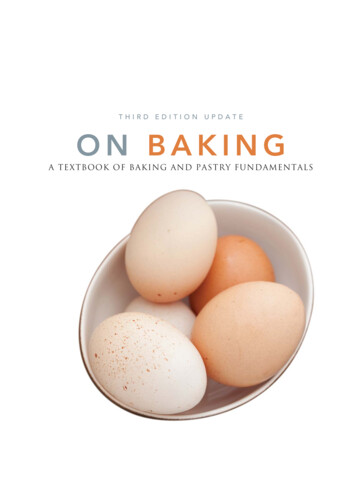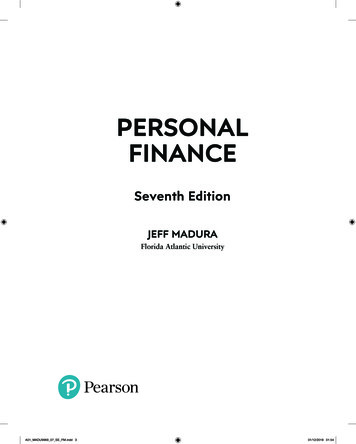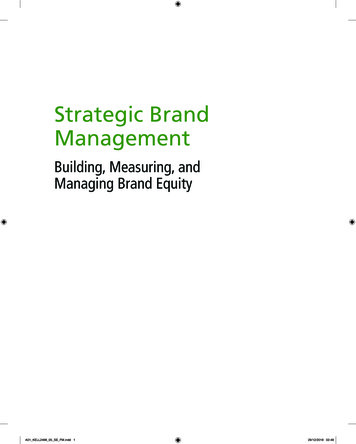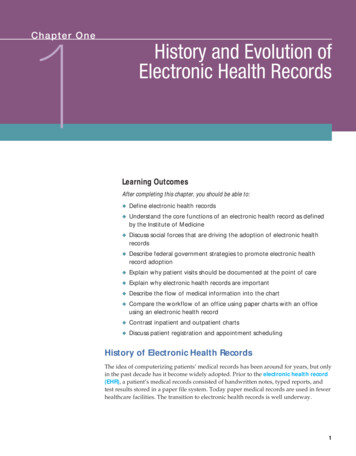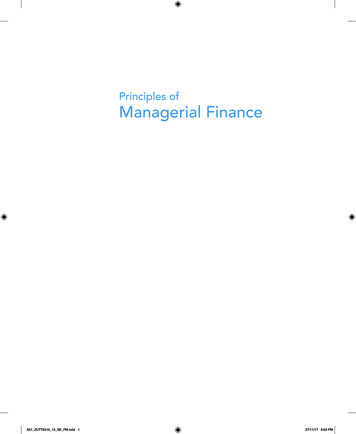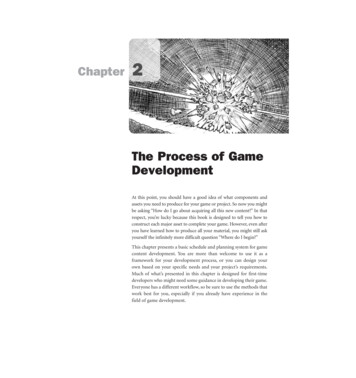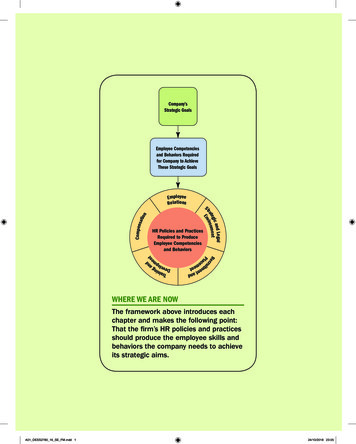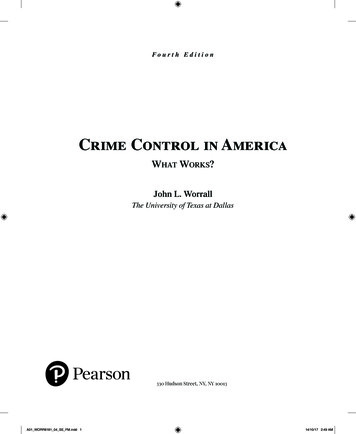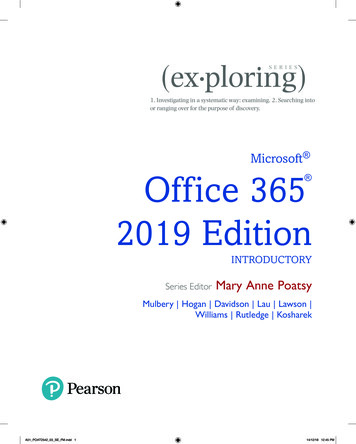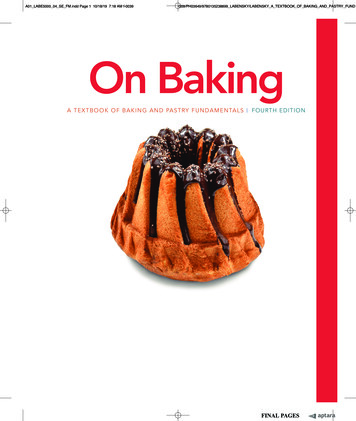
Transcription
A01 LABE5000 04 SE FM.indd Page 1 10/18/19 7:18 AM f-0039/209/PH03649/9780135238899 LABENSKY/LABENSKY A TEXTBOOK OF BAKING AND PASTRY FUNDOn BakingA TE XTBOOK OF BA KING A ND PA ST RY FUNDA MENTA LS FOURTH EDITION
A01 LABE5000 04 SE FM.indd Page 2 10/18/19 7:18 AM f-0039/209/PH03649/9780135238899 LABENSKY/LABENSKY A TEXTBOOK OF BAKING AND PASTRY FUNDApproach and Philosophy ofOn BakingRevel for On Baking Fourth EditionNew for this edition, On Baking isnow available in Revel—an engaging, seamless, digital learning experience. The instruction, practice, andassessments provided are based onlearning science. The assignabilityand tracking tools in Revel let yougauge your students’ understandingand engagement in and out of theclassroom. This visibility into studentperformance, paired with your students’ renewed energy for the material, empowers you to spend yourclass time on the meaningful instruction that only you can deliver. Formore details, see the ComprehensiveTeaching and Learning Packagepage ix.This new fourth edition of On Baking: A Textbook of Baking and Pastry Fundamentalsfollows the model established in our previous editions, which have prepared thousandsof students for successful careers in the baking and pastry arts by building a strong foundation based upon proven techniques. On Baking focuses on learning the hows andwhys of baking. Each section starts with general procedures, highlighting fundamentalprinciples and skills, and then presents specific applications and sample recipes or formulas, as they are called in the bakeshop. Core baking and pastry principles are explainedas the background for learning proper techniques. Once mastered, these techniques canbe used to prepare a wide array of baked goods, pastries and confections. The bakingand pastry arts are shown in a cultural and historical context as well, so that studentsunderstand how different techniques and flavor profiles developed.Chapters are grouped into four areas essential to a well-rounded baking and pastryprofessional:❶ Professionalism Background chapters introduce students to the field with materialon culinary and baking history, food safety, tools, ingredients and baking science.❷ Breads Five chapters focus on breadmaking, from basic quickbreads to yeast breadsand advanced artisan specialties such as sourdough breads and laminated doughs.❸ Desserts and Pastries Fundamental baking techniques used in the preparation ofcookies, pies, creams, custards, cakes and frozen desserts are explained and thendemonstrated with a wide range of formulas for components and finished products.A chapter on healthy baking and special dietary needs concludes this section.❹ Advanced Pastry Work Chapters on tortes and entremets, petits fours, chocolate,plated desserts, sugar work and confections demonstrate advanced concepts andtechniques.UPDATES Three new chapters expand coverage of yeast breads, cake assembly and sugar work. More than 375 new photographs and illustrations provide clear representations of core preparations that are the foundation of any good baking textbook. Over 60 new formulas and variations reflect up-to-the-minute trends in bakeries and foodservice operations. New step-by-step photographs emphasize stages in making key products such as yeast and sourdough breads, doughnuts, laminated dough, cake batters and pie crust,as well as cake decorating, torte assembly and advanced confectionery techniques. New photographs illustrate contemporary plate presentation styles to help students in their mastery of plating and presentation. Content revisions and updates were written to improve readability and align procedures, photos and recipes more closely. Content updates reflect current trends in the world of baking and pastry, such as theinterest in food safety, gluten-free baking, use of whole grains, plant-based foods andadvanced bread, pastry and confectionary techniques. Enhanced food science coverage highlights the functions of ingredients with additionalinformation on flavor wheels. Expanded tables and troubleshooting content is included throughout the text tohelp students master fundamental bakeshop items such as puff pastry, pies, éclairpaste and pastry cream.ii
A01 LABE5000 04 SE FM.indd Page 3 10/18/19 7:18 AM f-0039/209/PH03649/9780135238899 LABENSKY/LABENSKY A TEXTBOOK OF BAKING AND PASTRY FUNDVisual GuideM05 LABE5000 04 SE C05.indd120 10/17/19is2:15dividedPM f-0039/209/PH03649/9780135238899 LABENSKY/LABENSKY A TEXTBOOK OF BAKING AND PASTRY FUND.Easy tonavigate, On PageBakinginto bite-sizedsubsections to optimizethe learning process. We invite you to explore this new edition with the following guided tour through the features included.120CHAPTER FIVE After studying this chapter,you will be able to:BLearningObjectivesaking is a science that relies upon chemistry and the physics of heat transfer, plusEach chapter begins with clearlystated objectives that focus onwhat students can achieve byshop,a good understandingthe everyday science of the kitchen is fundamental tocompletingtheof material.a dash of microbiology. The actions that take place for a mixture of flour, fatdescribe and use various mixingand water to become a finished product are a function of scientific principles.methods, and explain the importanceUnderstanding this allows you to select ingredients and work with formulas more easily.of gluten and moisture in mixingM05 LABE5000 04 SE C05.inddPage or12010/17/19PM f-0039Though a degree in chemistryphysicsis not2:15a prerequisitefor working in the bake-/209/PH03649/9780135238899 LABENSKY/LABENSKY A TEXTBOOK OF BAKING ANDdescribe the three primary forms ofheat transfer and explain how heatsuccess. You will find different aspects of the principles discussed in this chapter demonM07 LABE5000 04 SE C07.indd Page 168 10/17/19 1:27 PM f-0039/209/PH03649/9780135238899 LABENSKY/LABENSKY A TEXTBOOK OF BAKING AND PASTRY FUND .affects batters and doughsstrated and expanded upon throughout this text.M05 LABE5000 04 SE C05.indd Page 120 10/17/19 2:15 PM f-0039/209/PH03649/9780135238899 LABENSKY/LABENSKY A TEXTBOOK OF BAKING ANDdescribe the various baking and cooking methods employed in the bakeshop describe the stages of the baking process explain the science of taste and basicflavor principlesapply the science of taste and basicflavor principlesMIXING METHODS AND TECHNIQUES120CHAPTER FIVEThe firststep in Cthepastries and other bakeshop products is the168H AproductionP T E R S E ofV Ebreads,Nmeasuring of ingredients as discussed in Chapter 4, Mise en Place. Once measured,ingredients must be mixed or combined correctly in order to achieve the desired results.The techniquesmixFthisorI Vcombineingredients affect the baked good’s final volume,After120C H studyingAusedP T toEREchapter,appearance and texture. Mixing assists with the following: read making dates back to ancient times. Over the centuries, bakers have learnedAfter studying this chapter,you bewill ablebe ableto:to:aking is a science that relies upon chemistry and the physics of heat transfer, plusyou willEven distribution of dry and liquid ingredients.to manipulate the basic ingredients—flour, water, salt and leavening—to producea dashofmicrobiology. The actions that take place for a mixture of flour, fat Breakdownemulsify to combine a fat and a liquid into afatsyeastandproperlyliquids, causing them to blendaorvastemulsifydo notThin-crusted baguettes, tender Parker House rolls, crispselect andofusevariety. Fatsof breads.Afterstudyingthischapter,homogeneous mixture by properly blending describereadilycombinewith water.Various mixing methodshelpfatschewyto comea finishedproducta samefunctionof scientific principles.flatbreadsandbagelsareby carefulselection andhandlingareof thekeydescribe and carry out the 10 stagesingredientsliquidsbeinto ablea homogenousmixture (a mixtureingredients.that is consistentthroughout).akingis thisa sciencethatuponchemistryandthephysicsof heat ortanceA renewedinterestinallowsthe traditionalcraftof bakinghas seen manynewartisaninvolvedinexplainyeast orkwith formulasmore easily. BB BChapter Introduction Activation of the proteins in wheat flour, causingthebakeriesformationtherecentelasticyears. Customers are demanding, and more restaurants arebreadopeninaaofdashof microbiology. The actions that take place for a mixture of flour, fatof glutenandcalledin mixing prepareamoisturevarietyof yeastbreads,gluten. Glutendevelopment is affectedby factorsincludingin chemistry or physics is not a prerequisite for working in the rtmentsat every meal. Although few baked goods que,fat,andmoisture,formula type and ingredients.and water to become a finished product are a function of scientific principles. describeandusevariousmixing describethe three primary forms ofshop,the aseverydayofmasterthe kitchen is fundamental tonovicebakers aas goodmuch asunderstandingyeast breads, few areofactuallyforgiving toscienceprepare. Byvarieties seanddevelopalightaerate to incorporate air into a mixturemethods,andandexplainthe howimportanceUnderstandingyouandto pastryselectofingredientsandcustomerswork g basicprocedurestechniques,bakerschefsoffer theirthrough sifting and mixing;to whip air tsthecanprinciplesdiscussedthis chapterdemontexturewhenbaked. graphssummarizeofglutenand moisturein mixinga mixture to lighten it, such as beating eggdelicious,freshly-bakedgoodsinmadewith yeast.or physics is not a prerequisite for working in the readCorrectly employing a variety of different mixing methodscan accomplishmany thingsstratedand expandedupon throughout this text.whites to a foamthe mainthemesinbasiceachchapterwith only athefewthreeingredients.(See Tablemixingmethods describeprimary formsof 5.1.) ForWeexample,shop,goodunderstandingthe everydaythe kitchen is fundamental todivide ayeastbreadsintosuchthree majorofcategories:basic leansciencedoughs, ofnaturally describe the various baking and pics.heattransfer employedand explainheatleavenedand ryeYoubreads,and rich differentdoughs. Basiclean doughs,suchprinciplesas those useddiscussedto makesuccess.willaspectsof thein this chapter demoningmethodsin howthein bakeshopCuttingalso combines ingredients,this case solid fat anddry ingredients,in afindspecificcrusty French and Italian breads, rolls and sandwich loaves, contain little or no sugaraffectsbattersdoughscrumb the interior of bread or cake; may beBeating, creamingupon,way to ensurethatanda doughbakes into a flaky crust stratedor XINGSuchdoughsare METHODSthefocus of this chapter. ANDNaturally-leavenedand rye breads areTECHNIQUES describethe whippingstages ofincorporatethe bakingelastic, aerated, fine or coarse grainedkneading andair processinto a batter,or foamduringmixing. describeand goodscook-theirmadefrom leanrequire special handling to bring out their unique flavor.Pockets theof airvarious(air cells)bakinggives bakedfinal textureafterdoughsbaking.thatA buttery explainthescienceof tasteandcakemethodsbatteror tendersandwichhasbasicmany tiny,Theyevenairdiscussedcells,givea sliceofingemployedinbreadthebakeshoparein Chapter8, PrefermentsandofNaturalStarters.Rich doughs,such as bakeshop products is theThefirstwhichstepin theproductionbreads,pastriesand otherairandcellschallahare createdexclusivelythe cakeprinciplesor bread a uniform fine texture or crumb. Theseflavorbriochedoughs,contain significantlymore sugarandfat than inChapteren Place. Once measured,during the themixingprocess.METHODSAND describestagesof the baking process Rich MIXINGdoughs bake into softerwith a tendercrust andTECHNIQUESinterior crumb. These areingredientsbeproductsmixedor combinedcorrectlyin order to achieve the desired results.Normally,fats do notblending,creaming,mustkneadingand applythe scienceof blendtaste withandwater.basicBeating,discussedin Chapter 9, Enriched Yeast Breads. A specific type of rich, flaky dough is madestirring breakfats intooftinytasteparticles,athehomog explaintheupscienceandallowingbasic them to blendThe withtechniquesto mix or combineingredientsaffectthe inbakedgood’sfinal roductsis theflavorprinciplesincorporatinglayersofand productionflour, referred toofas breads,lamination.pastriesThis doughis coveredenous mixture.Learn the difference in the mixingbytechniquesdescribedin ssists withthe following:measuringof Doughs.ingredientsMixingas discussedin Chapter4, Mise en Place. Once measured,Chapter10, Laminatedthen use the designated method with the appropriate equipment or tool to ensure aM01 LABE5000 04 SE C01.indd Page 15 17/10/19 2:43 PM gangaand texture.Mixing assistswiththe following:typesappearanceof yeast-raisedincludingsourdoughdiscussedin fats to emulsify enedVariousmixingbreadsmethodshelpChapter 8,and Natural Starters. To set yourself up for success, you may want PrefermentsEvenof dry andmixtureliquid ingredients.liquidsdistributionintoa homogenous(a mixture that is consistent throughout).to rereaddiscussionthe functionGluten is the tough, rubbery network of proteins createdwhenthewheatflour isofmixedwith of ingredients in Chapter 3, Bakeshop Ingredients, Activationemulsifycombinefat countryand a liquidinto aandbeforeBreak
plated desserts, sugar work and confections demonstrate advanced concepts and techniques. UPDATES Three new chapters expand coverage of yeast breads, cake assembly and sugar work. More than 375 new photographs and illustrations provide clear representations of core preparations that are the foundation of any good baking textbook. Over 60 new formulas and variations reflect up-to-the-minute .
